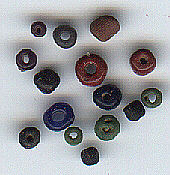The Bead Site =Home>Ancient Beads> India > Indo-Pacific Beads
Indo-Pacific Beads
Some 2400 years ago clever South Indians figured out how to stretch out 40 to 50 kilos (88 to 110 pounds) of glass into a thin tube and cut it into small pieces. They then tumbled these pieces over heat to round them off to make beads.
This is one of the most important beads of all times. Details on their history and manufacturing and on the glass analyses of them are available. There is also a page on the "mother site" of Arikamedu.
|
||||
These small Indo-Pacific beads really got around. They are found today from Ghana to China, Bali to Mali, South Africa to South Korea. For more than 2000 years these little beads have been traded all over the globe and deserve the title of "Champion Trade Bead" or even "Champion Trade Good."
The beads were first made in a port city on the southeast coast of India, known today as Arikamedu. In time, some of the beadmakers left to expand their trade. From about the first century A.D. until around 1200, some were living in Vietnam, Thailand, Malaysia, Indonesia and Sri Lanka, as well as their old home in India. Production was so enormous that for 1200 years in the relatively remote Philippines, Indo-Pacific beads account for two-thirds of all beads of all kinds excavated at all archaeological sites in the country.
From these remote times we have little evidence about how they were used. Certainly some were strung and worn as necklaces. Others were no doubt used in beadwork; a few more recent examples of their use this way have survived.
They are still being made today. Slowly, the industries outside India closed down, but the beadmakers stayed at Arikamedu until the 1600s or so when they moved to a village not too far north, Papanaidupet. They continue to make the beads, including some of the smallest in the world (see Biggest and Smallest Contemporary Glass Beads).
A complete treatment of the "mother site" that made Indo-Pacific beads and many stone beads is in Vimala Begley, ed. The Ancient Port of Arikamedu.Volume One has just been released; Volume Two (with the beads) will follow.
It will be announced here first.
__________________________________________________
Small Bead Businesses | Beading & Beadwork | Ancient Beads | Trade Beads
Beadmaking & Materials | Bead Uses | Researching Beads | Beads and People
Center for Bead Research | Book Store | Free Store | Bead Bazaar
Shopping Mall | The Bead Auction | Galleries | People | Events
The Bead Site Home | Chat Line | Contact Us | Site Search Engine | FAQ
